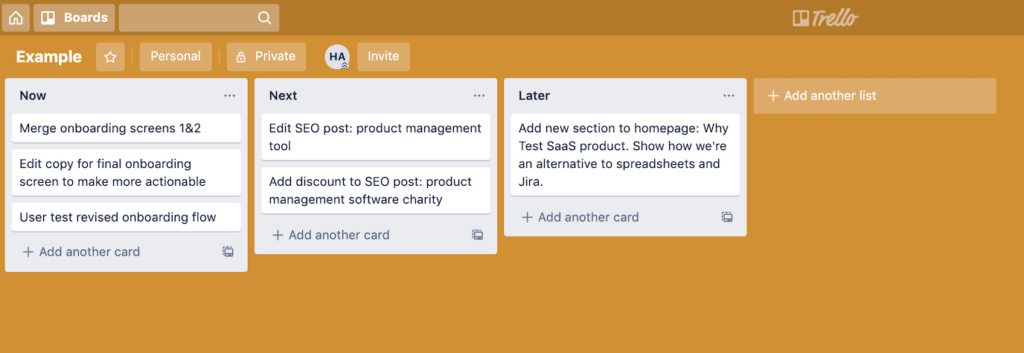Do you need a project management, feedback or roadmapping tool?
Whether you need a project management, feedback or roadmapping tool depends on what, specifically, you’re trying to achieve.
Is deciding on strategy for your product a priority? Or collecting and prioritising customer feedback? Or getting something built?
In this article we’ll clarify what each set of tools are, what they aim to do, and what problems they solve best. We’ll also include examples from each tool set.
Roadmapping tools like Aha!, Roadmunk and productboard
Roadmapping tools like Aha!, Roadmunk and productboard are designed to help you plan, share and develop new products and initiatives.
Sometimes they are called product management tools – the preferred term of productboard. The difference between product management and roadmapping tools is minimal though.
Roadmapping vs product management tools
Roadmapping tools can have a narrower remit than product management tools. However, both sets of tools usually cover fairly similar ground. A roadmapping tool like Aha! helps with ideation just as productboard, a product management tool, helps with roadmapping.
The main purpose of this type of tool is to help you develop product strategy, align your team around it, and decide at a high level on goals and, sometimes, a rough timeframe.
Roadmapping tools are usually full-featured web-based software that provide a more visual and shareable alternative to spreadsheets.
Many roadmapping tools give you a way to manage strategy (your goals, initiatives, how you stack up against competitors) as well as how you are going to deliver on this and what you’ll build.

Roadmapping tools specialise in drawing out insights from complex data, so you can see what is happening across many channels and teams, and how one action potentially impacts another.
They are ideal if you want one solution for a number of related issues like ideas, strategy, and goals.
They are not great, however, if your team already has an effective way of dealing with most of these issues. In this instance, you would be wasting money and time using complex (and sometimes expensive) software to solve a single problem like product execution or customer feedback.
Roadmapping tools are good at solving these problems:
- You have many tools that don’t work together and you feel your product strategy is a mess
- You need a visual and more powerful alternative to spreadsheets to speed up and simplify your product management processes
Roadmapping tools are not a great solution to these problems:
- You just want a tool to collect and prioritise customer feedback (try Feature Upvote)
- You just want a tool to manage project execution (Try Jira)
Customer and team feedback tools like Feature Upvote and UserVoice
Although some roadmapping and product management tools often have a portal for customer feedback, this can feel like an afterthought.
Purpose-built customer feedback tools like Feature Upvote and UserVoice specialise in helping you collect feedback in one place and prioritise it through voting.
Rather than replacing your entire product management workflow they usually ‘fit in’ with your existing workflow.
Feedback tools can help you build better products by showing you customer pain points in a way that is simple to understand. They save your team time manually dealing with suggestions and feature requests.
Public feedback boards also help engage your customers, by showing what happens when they give feedback. You add a status update like ‘under consideration’, ‘planned’ or ‘not planned’ for everyone to see.

Some feedback tools like Feature Upvote deliberately stay ‘simple’ so they are easy to use. Others, like UserVoice, aim upstream at bigger companies and give their customers more choices, resulting in a more complicated user interface and a much higher price point. Here’s our article comparing Feature Upvote to UserVoice.
Customer feedback tools are good at solving these problems:
- Messy and time-consuming processes for collecting and prioritising customer feedback
- Lack of customer input into product development leading to ‘feature flops’ where you’ve built what you thought customers needed rather than what they actually needed
Customer feedback tools are not a great solution to these problems:
- Problems delivering new products and initiatives (Try Jira)
- Too many tools for product strategy, development and roadmapping, leading to inefficient processes (Try productboard)
Project management tools like Jira, Trello, Asana and Basecamp
Project management and product management sounds rather similar. It’s easy to mix them up. However, they are very different and so are their tools.
Project management vs product management tools
Product management tools help you plan and communicate your product strategy. Project management tools help you track and execute that strategy.
There are a wide range of project management tools, including Jira, Trello, Asana and Basecamp. Roughly speaking, they do the same job. They help you execute a strategy or initiative.
Project management tools have different strengths though. Asana excels at being a ‘to do’ list. This type of project management tool continues to be popular because they are easy to understand and use.
Trello helps you track tasks and projects using simple Kanban-style boards. Jira does roughly the same, but has a raft of features designed to help you manage relationships and dependencies. Jira goes for configurable power rather than simplicity.

Basecamp, in contrast, concentrates on collaboration: on making sure that your team is working effectively together.
Project management tools are good at solving these problems:
- Delays and confusion delivering new products and initiatives
- Lack of team alignment around product execution
Project management tools are not a great solution to these problems:
- Lack of customer input into product development leading to ‘feature flops’ where you’ve built what you thought customers needed rather than what they actually needed (Try Feature Upvote)
- Too many tools for product strategy, development and roadmapping, leading to inefficient processes (Try productboard)
Build better products by surfacing valuable feedback
Start using Feature Upvote for free with our 30-day free trial
No credit card required
